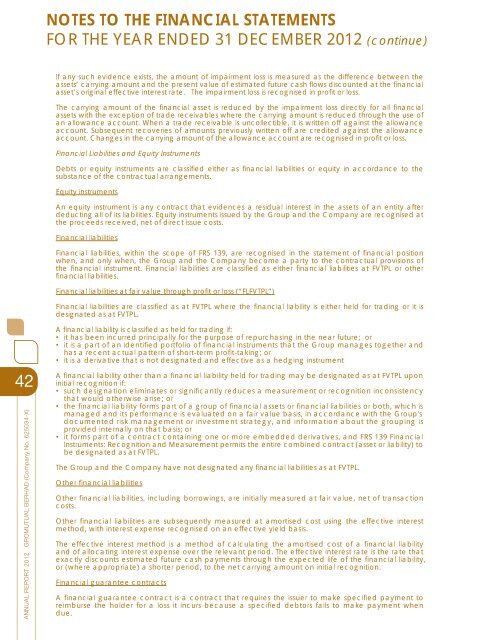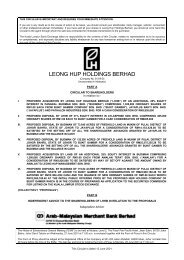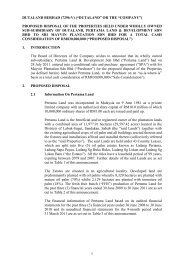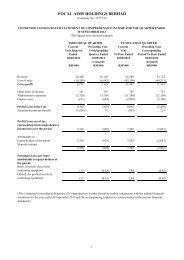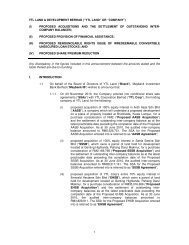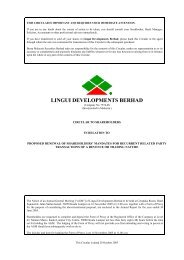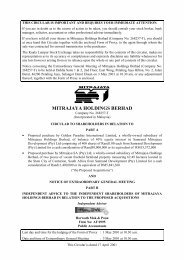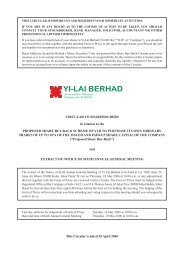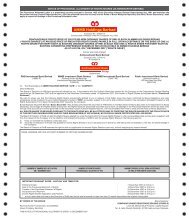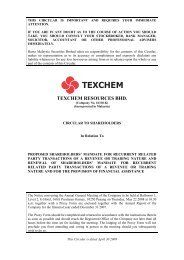Notice of Annual General Meeting - Announcements - Bursa Malaysia
Notice of Annual General Meeting - Announcements - Bursa Malaysia
Notice of Annual General Meeting - Announcements - Bursa Malaysia
You also want an ePaper? Increase the reach of your titles
YUMPU automatically turns print PDFs into web optimized ePapers that Google loves.
42<br />
ANNUAL REPORT 2012 GROMUTUAL BERHAD (Company No. 625034-X)<br />
NOTES TO THE FINANCIAL STATEMENTS<br />
FOR THE YEAR ENDED 31 DECEMBER 2012 (continue)<br />
If any such evidence exists, the amount <strong>of</strong> impairment loss is measured as the difference between the<br />
assets’ carrying amount and the present value <strong>of</strong> estimated future cash flows discounted at the financial<br />
asset’s original effective interest rate. The impairment loss is recognised in pr<strong>of</strong>it or loss.<br />
The carrying amount <strong>of</strong> the financial asset is reduced by the impairment loss directly for all financial<br />
assets with the exception <strong>of</strong> trade receivables where the carrying amount is reduced through the use <strong>of</strong><br />
an allowance account. When a trade receivable is uncollectible, it is written <strong>of</strong>f against the allowance<br />
account. Subsequent recoveries <strong>of</strong> amounts previously written <strong>of</strong>f are credited against the allowance<br />
account. Changes in the carrying amount <strong>of</strong> the allowance account are recognised in pr<strong>of</strong>it or loss.<br />
Financial Liabilities and Equity Instruments<br />
Debts or equity instruments are classified either as financial liabilities or equity in accordance to the<br />
substance <strong>of</strong> the contractual arrangements.<br />
Equity instruments<br />
An equity instrument is any contract that evidences a residual interest in the assets <strong>of</strong> an entity after<br />
deducting all <strong>of</strong> its liabilities. Equity instruments issued by the Group and the Company are recognised at<br />
the proceeds received, net <strong>of</strong> direct issue costs.<br />
Financial liabilities<br />
Financial liabilities, within the scope <strong>of</strong> FRS 139, are recognised in the statement <strong>of</strong> financial position<br />
when, and only when, the Group and the Company become a party to the contractual provisions <strong>of</strong><br />
the financial instrument. Financial liabilities are classified as either financial liabilities at FVTPL or other<br />
financial liabilities.<br />
Financial liabilities at fair value through pr<strong>of</strong>it or loss (“FLFVTPL”)<br />
Financial liabilities are classified as at FVTPL where the financial liability is either held for trading or it is<br />
designated as at FVTPL.<br />
A financial liability is classified as held for trading if:<br />
• it has been incurred principally for the purpose <strong>of</strong> repurchasing in the near future; or<br />
• it is a part <strong>of</strong> an identified portfolio <strong>of</strong> financial instruments that the Group manages together and<br />
has a recent actual pattern <strong>of</strong> short-term pr<strong>of</strong>it-taking; or<br />
• it is a derivative that is not designated and effective as a hedging instrument<br />
A financial liability other than a financial liability held for trading may be designated as at FVTPL upon<br />
initial recognition if:<br />
• such designation eliminates or significantly reduces a measurement or recognition inconsistency<br />
that would otherwise arise; or<br />
• the financial liability forms part <strong>of</strong> a group <strong>of</strong> financial assets or financial liabilities or both, which is<br />
managed and its performance is evaluated on a fair value basis, in accordance with the Group's<br />
documented risk management or investment strategy, and information about the grouping is<br />
provided internally on that basis; or<br />
• it forms part <strong>of</strong> a contract containing one or more embedded derivatives, and FRS 139 Financial<br />
Instruments: Recognition and Measurement permits the entire combined contract (asset or liability) to<br />
be designated as at FVTPL.<br />
The Group and the Company have not designated any financial liabilities as at FVTPL.<br />
Other financial liabilities<br />
Other financial liabilities, including borrowings, are initially measured at fair value, net <strong>of</strong> transaction<br />
costs.<br />
Other financial liabilities are subsequently measured at amortised cost using the effective interest<br />
method, with interest expense recognised on an effective yield basis.<br />
The effective interest method is a method <strong>of</strong> calculating the amortised cost <strong>of</strong> a financial liability<br />
and <strong>of</strong> allocating interest expense over the relevant period. The effective interest rate is the rate that<br />
exactly discounts estimated future cash payments through the expected life <strong>of</strong> the financial liability,<br />
or (where appropriate) a shorter period, to the net carrying amount on initial recognition.<br />
Financial guarantee contracts<br />
A financial guarantee contract is a contract that requires the issuer to make specified payment to<br />
reimburse the holder for a loss it incurs because a specified debtors fails to make payment when<br />
due.


